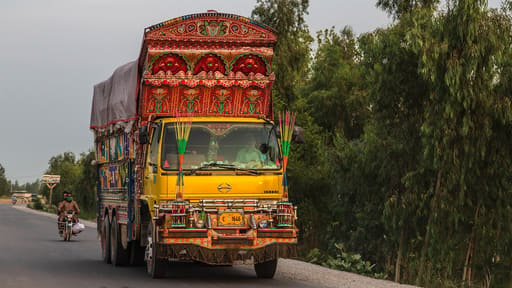Masterpiecies with a Load Capacity of over 3.5 Tons, or a Few Words about Art Trucks from Asia

The beginning of the new year is Carnival time. And Carnival means lights, colors and unrestrained fun. Did you know that there are places in the world where these attributes also describe trucks? This is no joke –in Asia, there is even an entire street culture created around decorating trucks with intricate graphics and colorful lights. These trucks are true works of art. However, they are not being exhibited in galleries, but continue to transport cargo from point A to B.
Japan: Dekotora
Collectors of miniature car models (or parents of children who play with die-cast cars) are probably familiar with the Hot Wheels brand. HW’s wide catalog of toy vehicles includes both replicas of real cars and fictional models. One of them is Raijin Express –a truck with a very distinctive silhouette, dripping with (plastic) chrome and decorated with kanji characters. Although the truck itself does not reflect any real model, the general concept behind it itself is very real. But let’s start from the beginning.
The year is 1975. The Japanese film studio Toei releases the first in a series of ten films about the adventures of “Torraku Yako”, or “Boys in Trucks”. Bunta Sugawara and Kinya Aikawa played the roles of rakish owners of trucks, distinguished by intricate, colorful decorations and lighting. Comedies about the love adventures of two Torraku Yako immediately became hits on the Japanese market, and the main characters’vehicles gained many followers in the real world. This is how the dekotora trend was born, which continues to this day.
The term “dekotora” (デコトラ) comes from the Japanese words “dekoreshon torakku” (デコレション トラック), which translates to “decorated truck”. At first, only fish transport trucks operating in the north-eastern part of Japan were dekotoras, but over the years, the popularity for decorating trucks with colorful paintings, silver and gold elements, neons, and now LED lighting, has spread to the entire country. Depending on the location, we can talk about Kanto-style dekotoras (the Honshu island region with the Tokyo metropolitan area) or Kansai-style ones (the central Honshu area with Kyoto and Osaka). Models decorated in a retro style are also popular, and many owners often choose to decorate their trucks with the characters from manga and anime, especially from the “Mobile Suit Gundam”series. Dekotoras are mostly box trucks from the most popular brands on the Japanese market: Hino, Mitsubishi Fuso and Isuzu. These are real works of art on wheels, unique, because no two dekotoras are the same. They are also proof that the combination of commercial vehicles and the magic of the silver screen can give birth to a new street culture that is still thriving.
India and Pakistan: Jingle trucks
The name jingle trucks was conceived by American soldiers stationed in Afghanistan during the war in 2001-2021, when they first saw colorfully decorated trucks plying the routes between Pakistan and Afghanistan. Of course, the tradition of decorating trucks with intricate floral patterns and calligraphy inscriptions by drivers from India and Pakistan is much older.
But why the term jingle trucks at all? Most likely because of the jingling sounds that these trucks emit while driving thanks to bells and chains attached to bumpers and cabs.
What do drivers put on their jingle trucks? Most often, paintings reminding them of their hometowns or important events in the history of India and Pakistan, but also fragments of poems, songs or religious texts. Some artists who prepare decorations for jingle trucks become real famous among Indian and Pakistani drivers, and the value of decorations and decorative parts may even be several times higher than the value of the vehicle itself, especially when it comes to decades-old trucks of brands such as Tata, Mahindra or Ashok Leyland to name only few.
Philippines: Jeepney
We will now move away from the transport of goods to the transport of people, but when describing the fabulously colorful commercial vehicles from Asia, we cannot omit the Philippines and one of the symbols of this country –the Jeepney.
The word “jeepney”is a portmanteau of the words “jitney”, meaning a local taxi in which more passengers can travel at the same time, and “jeep”, an American military off-road vehicle. Jitneys were a popular form of public transportation in Manila and other Philippine cities when the Philippines was a US colony. After World War II, in the already independent Philippines, military jeeps from the US Army surplus became popular. Very quickly they began to be converted into jitneys. Not only were the bodies lengthened to accommodate more passengers, but they were also painted in bright colors and decorated with paintings. Over the years, not only original American-made Jeeps, but also their licensed versions from Japan (Mitsubishi Jeep) or India (Mahindra) served as jeepneys. Soon, they were replaced by more modern Japanese off-road vehicles such as the Nissan Patrol, but also by pickup trucks. Today, over half a million people work as jeepney drivers throughout the Philippines. Although the jeepney is a symbol of the Philippines, its continued survival may be in question due to the development of modern public transport networks in the country’s largest cities, as well as increasingly stringent safety and exhaust emissions standards.